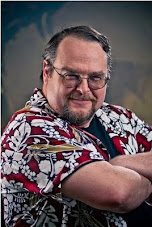So for the past two weeks, since Christmas, I have been living a triple life. Life One has been as Jeff Grubb, mild-mannered web copywriter/contractor for a large toy/entertainment company. Life Two has been Jeff Grubb, mild-mannered freelance author.
And Life Three has been as Thunderchild, Tauren Hunter out of Mulgore, who has just reached Crossroads in the Barrens with his pet cougar, Emily, and is hunting screeching raptors for their horns.
Yes, its got me as well. The time-suck that is World of Warcraft.
I blame my co-workers, many of whom were in the beta tests, and who have been playing it since it arrived in early December. The bad news is that they are at 40 level when I was at 10. The good news is that they formed a guild (Markovians) and I got my official hunter-green clan shirt from them (Stylin'!). And a couple 10-slot silk bags from our high-level tailor.
Hmm. Maybe I should start again. I've been rather suspect of Massively Multiplayer Online Roleplaying Games (MMORGs, among other abreviations) through much of their evolution. Most of the earlier versions have struck me as nice, but not enough to cause me to want to invest time and a monthly charge into them. City of Heroes was a great eye-opener for me, but when one of their updates went beyond what my PC laptop could run, I dropped out. World of Warcraft definitely creates addictive behavior, and I can see why.
First off, the game is visually stunning. It is beautiful world that one of my co-workers describes as "twisted Disney". The characters and their surroundings are more cartoony than realistic, and that works great - it draws you into the area. I have been playing in the Tauren (minotaur) area, which is mountainous upland with wide valleys, their architecture influenced by Native American background.
Further, they do all sorts of little things, bits of stage business that enhance the reality. Birds and bats flit across the sky, tribal dancers celebrate and then rest, spinning wind-powered totems grind grain and draw water. You get the feel of an alien but accessible landscape. Yes, you can see the standard building types being used repeatedly, but there are enough types that it does not get boring. It is cool, dyanamic world.
The game play, however, is what makes this addictive. WoW uses what we at TSR used to call "Matrix" design, as opposed to a linear design model. Linear design is a path - you do x, then move up the road and do y and then z. Straightforward story-telling. Your typical D&D adventure. Matrix design is more like an amusement park - You arrive and can go to rides A, B, or C in any order (now, A, B, and C may be linear themselves, or have their own matrices). The combination of exploring and quests brings the character through the world, and gives him enough rational to keep going. Indeed, the continual need to upgrade to meet new challenges is a standard feature of MMORGs and is handled very well here. Standing from the outside, I mocked my co-workers use of non-combat abilities ("You're a wizard! Why do you need to worry about tailoring?"), but within two days of immersion, I was there skinning zebra-unicorns and using leatherworking to make boots for sale. Its insidious, I tell you.
Similarly, the nature of grouping and the social interaction within the game. While I don't think that the social nature of online games has yet to reach that of old-fashioned tabletop RPGs (primarily because there is not that instant response, but rather the slower give and take of email or instant messaging), there is a social component, both on a local level (grouping up with strangers to take on opponents) and at a larger level (real-world friends who form guilds). What WoW and similar games provide is a grounding for discussion out of the direct gaming experience (what Richard Garfield always called the "Metagame"). And yes, I have spent several lunch hours now comparing the differences between the hunter and rogue experiences.
And that's the last nice point - the first time you are in the game, it has an amazing sense of wonder. But the playing style of the hunter is different from that of the warlock is different from that of the paladin. Further, from discussions I've been involved in, there are different shades of play among the races as well - orc versus undead versus human. And there is a major break between the Horde and Alliance, such that players on opposing sides do not communicate and are expected to fight on sight. All these different variants make for high replayability out of a single engine.
All in all, its a very impressive accomplishment, and a game which takes the art of online RPGs forward. I can see our D&D roots here (High-tech gnomes - now what lunkhead came up with THAT idea?), but they have adapted incredibly well for the computer medium.
Oh, and if you're on the Uther server, say hi to Thunderchild. If you're Alliance, you can just wave at him as he opens fire with his blunderbuss.
More later,
My Newest Publication: DARK TOWER
-
*So, *
So, one of the things I saw at GaryCon that interested me greatly was the
new expanded edition of *DARK TOWER*, by the late great Jennnell Jaquay...
1 day ago


